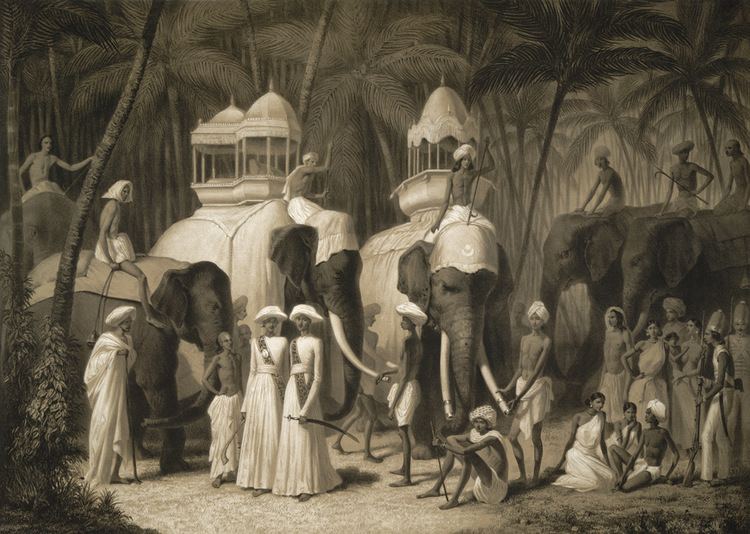 | ||
A howdah, or houdah (Hindi: हौदा haudā), derived from the Arabic هودج (hawdaj), that means "bed carried by a camel", also known as hathi howdah (हाथी हौदा), is a carriage which is positioned on the back of an elephant, or occasionally some other animal such as camels, used most often in the past to carry wealthy people or for use in hunting or warfare. It was also a symbol of wealth for the owner, and as a result was decorated with expensive gems.
Contents
Most notable are the Golden Howdah, the one used in display at the Napier Museum at Trivandrum which was used by the King of Travancore and the one used traditionally during the Jamboo Savari (Elephant Procession) of the famous Mysore Dasara. The Museum at the Mehrangarh Fort, Jodhpur, Rajasthan has a gallery of royal Howdahs.
In the present time, howdahs are used mainly for tourist or commercial purposes in South East Asia and are the subject of controversy as animal rights groups and organizations, such as Millennium Elephant Foundation, openly criticize the use of the howdah, citing information that howdahs can cause permanent damage to an elephant's spine, lungs, and other organs and can significantly shorten the animal's life.
Howdah Gallery, Mehrangarh Fort Museum
The Mehrangarh Fort Museum, Jodhpur, has a gallery dedicated to an array of Hathi Howdah, used by the Maharaja of Mewar, mostly for ceremonial occasions.
Elephant and castle symbol
A derived symbol used in Europe is the "elephant and castle": an elephant carrying a castle on its back, being used especially to symbolize strength. The symbol was used in Europe in antiquity, and more recently has been used in England since the 13th century, and in Denmark since at least the 17th century.
In antiquity, there was Roman use of war elephants, and turreted elephants feature on the coinage of Juba II of Numidia, in the 1st century BC. Elephants were used in the Roman campaigns against the Celtiberians in Hispania, against the Gauls, and against the Britons, the ancient historian Polyaenus writing:
Caesar had one large elephant, which was equipped with armor and carried archers and slingers in its tower. When this unknown creature entered the river, the Britons and their horses fled and the Roman army crossed over.However, he may have confused this incident with the use of a similar war elephant in Claudius' final conquest of Britain.
Alternatively, modern uses may derive from later contacts with howdahs. Fanciful images of war elephants with elaborate castles on their back date to 12th century Spain, as at right.
Notably, 13th century English use may come from the elephant given by Louis IX of France to Henry III of England, for his menagerie in the Tower of London in 1225, this being the first elephant in England since Claudius; see History of elephants in Europe.
Today the symbol is most known from the Elephant and Castle intersection in south London, which derives its name from a pub, using the old site of a cutler's, who had used the symbol of the Worshipful Company of Cutlers. The Cutlers, in turn, used the symbol due to the use of ivory in handles.
The elephant and castle symbol has also been used since the 13th century in the coat of arms of the city of Coventry, and was used in the 17th century by the English slaving monopoly, the Royal Africa Company, which led to its use on the guinea coin.
The symbol of an elephant and castle is also used in the Order of the Elephant, the highest order in Denmark, since 1693.
Another example of an elephant image from India that was modified in the move to Europe is the change from the elephant piece in Chaturanga (ancient Indian chess) to the bishop piece in European chess, clergy replacing elephantry.
Camel howdah
The Viceroy's Howdah at Viceregal Lodge, Simla
